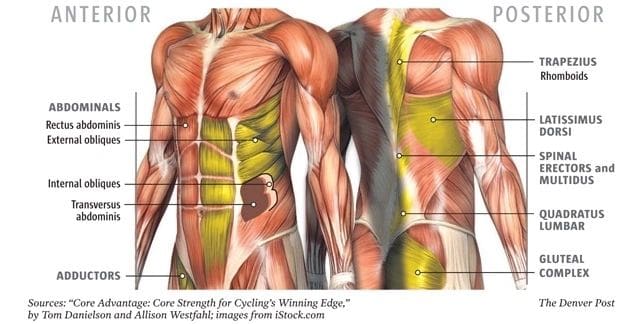
Back: Core Strength and Stability
Introduction
The most important part of core training is proper form. Training your core muscles with improper form can cause more harm. But don’t let this scare you off. This blog post is here to help make core strengthening safe and simple.
Core strengthening is important in the balance between stability and mobility in your spine. Core stability is the interaction between the skeleton muscular system, nervous system and external forces on the body. Some of these forces are constant, like gravity, some are expected, like stepping down a stair, and some of them are unexpected, like getting bumped into by someone in public. Whatever the force on your core, the body should be able to react efficiently and effectively.
Why Core stability training?
Core stability can decrease the rate of injury by increasing balance and proprioception (knowing where you are in space). Increased muscle strength and endurance can protect joints from injury. Training your core will help take pressure off your passive structures such as ligaments and discs by using your muscles to maintain correct body alignment. Putting unneeded stress on your passive structures is a recipe for injury.
The main muscles of your core consist of more than your six pack “rectus abdominis.” Your core is an interaction between the muscle of your back and your stomach. A coordinated effort of these muscles help maintain a healthy spine and much more.
The core muscle complex needs to function in tandem with hip stabilizers (your base) and scapular stabilizers. These muscle groups function to maintain proper posture (see posture blog). Maintaining good posture without effort or thought is the ultimate goal, but this takes practice and a strong core. This blog post will provide a core workout for beginners. It will also provide some other core strengthening exercises and progressions to improve your core strength and stability.

Exercises
Plank progressions:
Planks: Planks are a great way to increase your core stability with no equipment. These are easy to incorporate at all strength levels. Helpful tips to maintain proper alignment in a plank:
- Squeeze your belly button to your spine.
- Squeeze your butt like there is a quarter between your butt cheeks.
- Squeeze your shoulder blades together to help establish a straight line from your ears, to your hips, to your ankles.
Side plank: This plank variation not only works your abdominal complex but also activates your hip abducts (gluteus medius). The glute muscles connect to your pelvis and function as the base of your spine. The base maintains a strong foundation for your spine and core to build off. This is why glute/hip strengthen and stabilization exercise are always a focus in any spinal rehab.
Tips for side planks
- .Follow the same instructions as a standard plank.
- Make sure to pick a progression that you are able to maintain a successful body position without falling.
- Place both feet on the floor if balancing becomes an issue.
Bridging Progressions:
Bridge: Bridge variations are a great way to engage and strengthen your glutes. Your glutes help stabilize the base of your spine and allows for proper alignment throughout the entire spine. Glute engagement and strengthening is a great way to increase stability in your core and spine.
Tips for Bridging
- Maintain the same core alignment as a plank.
- Full foot should be engaged on the floor.
- Push knee out while maintaining heel and big toe engagement on the floor.
- For added challenge add a theraband around the knees and push out when you are lifting up.
Single Leg Glute Bridge:
- Follow the same instructions for a bridge
- Hold one leg up while bridging
- Don’t let the hip drop, maintain a stable core
The YouTube Video attached to this Blog gives you demonstrations on each exercise and how to progress to continue to challenge your strength.
Physical Therapy intervention
A Physical Therapy session focusing on increasing core stability and activation is more than holding a few planks. A skilled provider will assess your ability to engage different components of your core and help train you to make this an automatic response to external forces. This coupled with manual therapy helps expedite the healing process.
If you are experiencing back pain or stiffness, Physical Therapy can help! Please contact us at Dynamic Physical Therapy – Chicago and Follow and Like us on Instagram and Facebook.
Please call (312) 643-1555 or email info@dynamic-PT.com with any questions or to schedule your consultation today.
